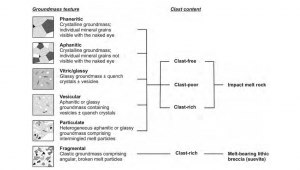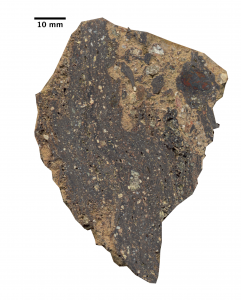The rocks affected by the impact are not limited to the rocks within the crater rim, but rather can be found below the crater, outside the rim, and within the crater itself. There are also several different types of impactites produced by the impact cratering process. We have divided them up here into Shocked Rocks, Impact Melt Rocks, and Impact Breccias.
Shocked Rock

During the impact cratering process, the compression, decompression, and heating caused by the impactor lead to deformation and transformation within the surrounding rocks that are hit by the impactor. As this change is caused by a shock wave, we call this change shock metamorphism. The fact that impact structures are associated with shock metamorphism is what makes these structures truly unique as no other surficial process on Earth is able to reach such high pressure.
As the rock undergo such high levels of pressure, the rocks, and minerals they are made up of, undergo significant change. On the outcrop scale, between 2-10 GPa, shatter cones form within different lithologies. Shatter cones are the only distinctive shock-deformation feature that can be seen with the naked eye. As observed in the image, shatter cones are curved with striated fractures that typically form partial or complete cones. They are usually found within the central uplift of an impact structure and their occurrence has been reported for more than half of all currently confirmed impact structures. The formation of shatter cones, while widely accepted as unequivocal proof of a meteorite impact crater, is not completely understood though they are thought to form very early during the impact process.
Most shock metamorphic features are found on the micro-scale features, where the high pressures causing deformation features to form. Not all of these features are unequivocal evidence of hypervelocity impact event. For example, planar fractures, feather features, mosaicism, and kink banding can all form through other geologic processes, such as high-pressure events associated with mountain forming and subduction. During deformation, different mineral phases break along planes of weakness dictated by the crystal structure of the mineral. As seen in the figure these features are observed within a range of different minerals. The one micro-scale deformation feature that is considered definitive evidence for shock metamorphism and the presence of an impact structure are planar deformation features (PDFs) in quartz grains. Unlike other planar fractures, PDFs do not open fractures. Rather PDFs are typically narrow, planes of amorphous material that are very thin comprising straight, parallel sets. From Experiments, we know that these features form at pressures between 5-35 GPa.
As rocks experience higher pressures, the minerals crystal structure can undergo what we call solid-solid transformation. Mineral phases can form high-pressure polymorphs, that is, they are made of the same material but have a different structure. A commonly know transformation is the transition of graphite to diamond; both are pure carbon but have a different crystal structure that forms at pressures between 30 and 40 GPa. Quartz (SiO2) also has two polymorphs coesite and stishovite which form at pressures between 30 and 60 GPa and between 12 and 45 GPa respectively. The final solid-solid transformation that can occur is the formation of diaplectic glass, where minerals form glass and loss their crystal structure without melting.
Impact Melt Rocks
During a hypervelocity impact, as the rock undergo high shock pressure and temperatures large amounts of melting can occur. Unlike other forms of melting that is observed on the surface of the Earth, where thermodynamic relations dictate the degree of melting, impact melting is dependent on the shock pressure caused by the impact and the compressibility, that is the physical properties, of the target rocks that have been hit. Further details about the impact melting process can be found in chapter 9 in the book Impact Craters: Processes and Products.
Impactites that bear a melt phase are classified and described based on textural characteristics of the groundmass/matrix, the melt phases, and clast content. The figure below is a proposed classification scheme that is frequently used to described different impact melt-bearing rocks.

matrix, with respect to melt phases, and clast content (Osinski et al., 2008)

Impact melt-bearing rocks can be found within the crater, proximally outside, and as distal ejecta. Based on terrestrial craters and satellite observations of the Moon, we know that melt-bearing impactites can form large ponds of melt that has cooled in place. It also can be ejected from the crater and mixed within the ejecta blanket. Beyond the crater, the melt can be launched forming what are called tektites. Tektites are glass that is aerodynamically shaped bodies that landed beyond the continuous ejecta blanket as shrewn fields.
Impact Breccias
A breccia (Latin word meaning “broken”), in general, is a rock that is a mixture of angular fragments of different types of rocks surrounded by a fine-grained matrix/groundmass that may be similar to or different from the fragmented material. While breccias form in a range of different geologic settings, such as river deposits or volcanic eruptions, these rocks also commonly form in impact craters. These breccias may contain melt-bearing phases as clasts, but they may also be purely lithic, that is a mix of fragmented target rock and shocked rocks that are surrounded by a fine-grained matrix of the same pulverized target rock.
Impact breccias occur throughout the impact structure can be a product of a number of different processes occurring during the impact cratering process. Breccias can form as the shockwave pass through the target material causing a mass flow, brecciation can occur during ejection of material, or during the final modification of the crater as material continues to deform. A “breccia-in-breccia” texture has also been involved suggestion multi-generational breccia forming events occurring during the formation of a single impact structure.
Impact breccias are observed in a range of morphology throughout impact structures, and while they are commonly observed as massive continuous units, impact breccias can also form dykes. Geologically dykes references to material that is cross-cutting a target rock, and therefore it is thought, that the brecciated material is injected and emplaced as the crater expands. As suggested above, multi-generational breccia dykes are also observed. These cross-cutting relationships are important in understanding the timing of different process occurring within the impact structures formations.